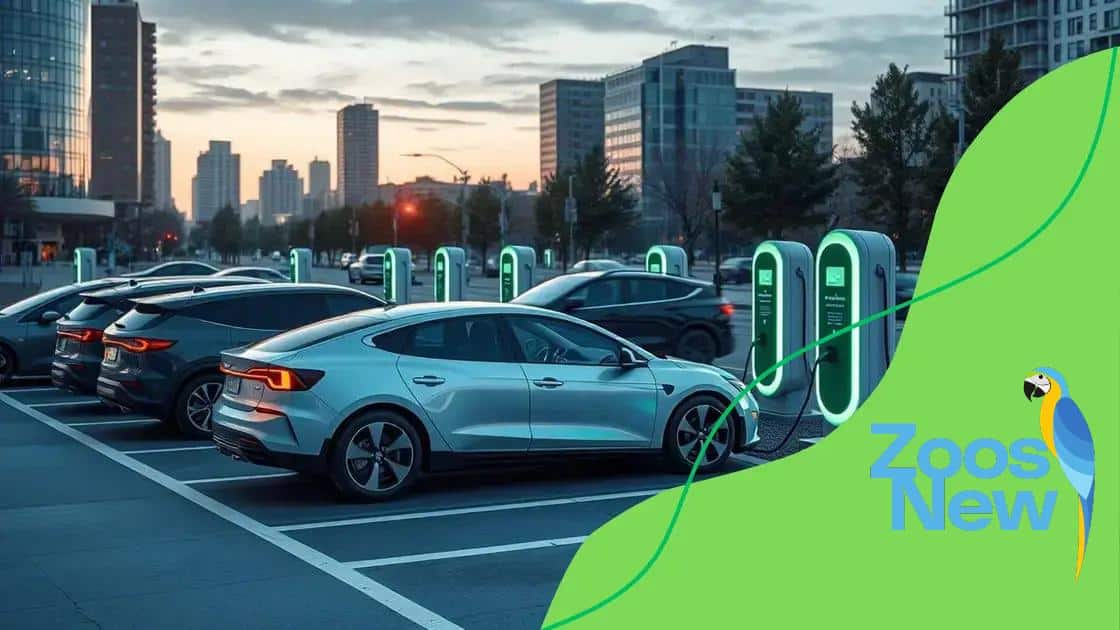The rise of electric vehicles in 2025: what to expect

The rise of electric vehicles (EVs) is driven by technological advancements, government incentives, and changing consumer attitudes, but challenges such as infrastructure limitations and battery production must be addressed to ensure widespread adoption.
The rise of electric vehicles in 2025 is more than just a trend; it represents a significant shift in how we think about mobility. Ever wondered how this will impact your daily commute or the environment? Let’s dive into the key elements driving this transformation.
Current market trends for electric vehicles
The current market trends for electric vehicles reveal exciting developments that are shaping the auto industry. As more consumers turn to electric options, understanding these trends helps us see the future of transportation.
Growth in Demand
One major trend is the increasing demand for electric vehicles (EVs). Sales have surged as people become more environmentally conscious. This shift is influenced by many factors, including rising fuel prices and a stronger commitment to sustainability. Many buyers are now prioritizing eco-friendly vehicles in their purchasing decisions.
Technological Innovations
Technology plays a crucial role in the rise of EVs. New innovations help improve battery life, charging speeds, and overall vehicle performance. As a result, manufacturers are introducing more efficient models that appeal to a broader audience. This technological evolution is making EVs more accessible than ever before.
- Enhanced battery technologies.
- Faster charging infrastructure.
- Advanced driver-assistance systems.
The government is also a critical player in this market. Policies aimed at reducing carbon emissions encourage consumers to consider electric options. Incentives like tax breaks and rebates can make these vehicles more affordable for the average buyer. Additionally, many states are increasing the number of charging stations, making it easier to own an EV.
Changing Consumer Preferences
Today’s consumers are smarter shoppers. They research extensively before making a purchase. As the EV market grows, so does the information available about these vehicles. Auto buyers are now looking for information about total cost of ownership, resale value, and the environmental impact of their choices.
When it comes to the current market trends for electric vehicles, it’s clear that the landscape is evolving. With ongoing technological advancements and shifting consumer attitudes, the future looks bright for electric mobility. More individuals are enjoying the benefits of driving an EV, making it an exciting time for both enthusiasts and newcomers alike.
Technological advancements in EVs
Technological advancements in electric vehicles (EVs) are transforming how we think about transportation. Innovations are making these vehicles more efficient, accessible, and appealing to a wide range of consumers.
Battery Technology Improvements
One major area of advancement is in battery technology. New materials and designs are leading to longer-lasting batteries that charge more quickly. This means EVs can travel further on a single charge, reducing range anxiety for drivers.
- Solid-state batteries for increased safety.
- Fast charging capabilities, often under 30 minutes.
- Improved energy density for longer range.
Additionally, the use of regenerative braking systems is becoming more common. This technology captures energy that would normally be lost during braking and redirects it to recharge the battery. As these technologies advance, the efficiency and attractiveness of EVs continue to grow.
Enhanced Charging Infrastructure
Another key trend is the expansion of charging infrastructure. More charging stations are being installed in urban areas, highways, and public spaces. This makes owning an EV more convenient and encourages more people to consider switching. Many new homes even come equipped with charging capabilities.
App-based services are also emerging, helping drivers locate nearby charging stations and check availability in real-time. This integration of technology and user experience simplifies the ownership of electric vehicles.
In addition, manufacturers are integrating advanced features into EVs. For example, many models now come equipped with smart technology that allows for real-time vehicle monitoring, navigation aids specific to charging station locations, and connectivity to smart home devices.
As we see these technological advancements unfold, the landscape of electric vehicles becomes increasingly inviting. From enhanced battery systems to a robust charging infrastructure, these innovations are setting the stage for a sustainable future on the road.
Government policies influencing EV adoption

Government policies influencing EV adoption play a crucial role in shaping the electric vehicle market. These policies not only encourage consumers to switch to electric but also support manufacturers in the transition.
Incentives and Rebates
Many governments offer incentives to promote the use of electric vehicles. These can include tax credits, rebates, and grants for both buyers and manufacturers. By making EVs more affordable, these incentives lower the barrier for entry for new customers, encouraging them to choose an electric model.
- Federal tax credits that lower the purchase price.
- State incentives for charging infrastructure installation.
- Grants for manufacturers to develop new EV technologies.
As these financial incentives grow, more people are considering the benefits of going electric. This financial support helps not only individual consumers but also fosters a competitive market among manufacturers.
Emissions Regulations
Another significant factor is the introduction of stricter emissions regulations. Governments worldwide are implementing rules that limit the amount of carbon dioxide and other pollutants that vehicles can emit. This pushes car manufacturers to invest more in electric technologies to meet the new standards.
These regulations drive innovation as companies seek to create cleaner vehicles. Manufacturers that fail to comply face hefty fines or restrictions, further incentivizing the shift toward electric vehicles. This creates a ripple effect, positively influencing the atmosphere and public health.
By reviewing these policies, we see that the influence of government on EV adoption is profound. From financial incentives to stringent regulations, every strategy is aimed at promoting a cleaner and greener future through electric vehicles. The collaboration between government and industry is essential in fostering a sustainable automotive ecosystem.
Consumer attitudes toward electric vehicles
Consumer attitudes toward electric vehicles are evolving rapidly as people become more aware of the benefits and challenges these vehicles offer. As electric vehicles (EVs) gain popularity, understanding these attitudes can provide valuable insights into market trends.
Perceptions of Environmental Impact
Many consumers are drawn to EVs due to their potential positive impact on the environment. With increasing concerns about climate change, more individuals are eager to reduce their carbon footprint. The perception that electric cars are eco-friendly plays a significant role in their appeal.
- Belief that EVs help reduce greenhouse gas emissions.
- Desire for sustainable transportation options.
- Awareness of the harmful effects of fossil fuels.
This heightened awareness often drives people to consider electric vehicles as a viable alternative to traditional gasoline-powered cars.
Concerns About Charging and Range
Despite the enthusiasm for EVs, some consumers still harbor concerns about charging infrastructure and vehicle range. Many individuals worry about the availability of charging stations and the time required to recharge their vehicles. These concerns can create barriers to adoption.
Range anxiety remains a significant issue, especially for those who frequently travel long distances. While improvements in battery technology are addressing these concerns, potential buyers may still hesitate to fully commit to an electric vehicle.
Additionally, education around charging options is crucial. Many consumers are not aware of the different charging levels and home installation possibilities, which could help alleviate some of their concerns.
Incentives and Market Availability
Government incentives and the growing availability of electric models also influence consumer attitudes. Many buyers are encouraged by financial incentives, such as tax credits or rebates. These incentives make EVs more appealing and may sway potential customers who are on the fence.
The increasing number of manufacturers entering the market has led to more choices and better designs, which further impacts consumer perception. With diverse options available, buyers can find an electric vehicle that suits their needs, whether it’s for commuting, family use, or performance.
Overall, consumer attitudes toward electric vehicles are complex, shaped by environmental concerns, practical considerations, and the influence of incentives. As perceptions continue to shift, the landscape for electric vehicles is likely to evolve even further.
Challenges faced by the EV industry
The challenges faced by the EV industry can significantly impact its growth and consumer acceptance. While electric vehicles (EVs) are gaining momentum, various obstacles must be addressed to ensure their future success.
Infrastructure Limitations
A major challenge is the lack of adequate charging infrastructure. Many regions still do not have enough charging stations, making it difficult for drivers to find convenient places to recharge. This can lead to range anxiety, where potential buyers worry about running out of battery during their travels.
- Inconsistent availability of fast charging options.
- Limited home charging capabilities in urban areas.
- High costs of installing new charging stations.
Improving this infrastructure is crucial for helping consumers feel confident about switching to electric vehicles.
Battery Production and Resource Supply
Another significant hurdle is the production of batteries. The demand for batteries is rising, but sourcing materials like lithium, cobalt, and nickel can be problematic. Mining these materials often involves environmental and ethical issues.
Additionally, as demand increases, the risk of supply chain disruptions grows, which can lead to higher costs for manufacturers. Finding sustainable and ethical sources for battery materials is essential for the long-term viability of the EV industry.
Market Competition and Innovation
The EV market is becoming increasingly competitive, with traditional automakers and new startups all vying for market share. This competition can spur innovation but can also lead to market saturation, making it difficult for individual companies to stand out.
Companies need to continuously innovate to attract buyers, focusing on features like longer ranges, faster charging, and improved technologies. As a result, staying ahead in this fast-paced market can be a challenge for many players.
In addition to these challenges, educating consumers about electric vehicles is vital. Many people still have misconceptions and a lack of understanding regarding EV technology and its benefits. Overcoming these hurdles will require coordinated efforts between manufacturers, governments, and advocacy groups.
By addressing these challenges, the EV industry can continue to grow and evolve, paving the way for a more sustainable future.
FAQ – Frequently Asked Questions about Electric Vehicles
What are the main benefits of driving an electric vehicle?
Electric vehicles (EVs) offer lower operating costs, reduced environmental impact, and often provide a quieter and smoother driving experience.
What challenges does the EV industry currently face?
The EV industry faces challenges such as limited charging infrastructure, battery production issues, and consumer concerns about range and charging times.
How can government policies help promote electric vehicle adoption?
Government policies can promote EV adoption through incentives, tax credits, and developing more charging stations, making EVs more accessible to consumers.
What should consumers consider when purchasing an electric vehicle?
Consumers should consider charging options, range, available incentives, and the total cost of ownership when purchasing an electric vehicle.


